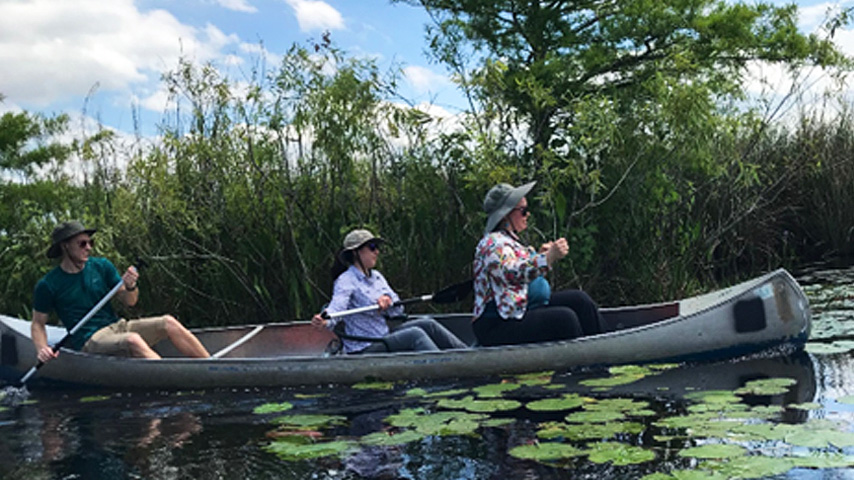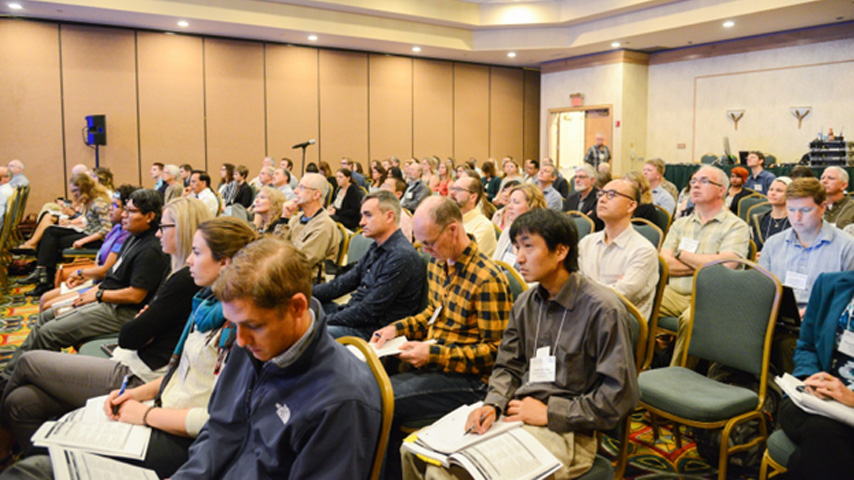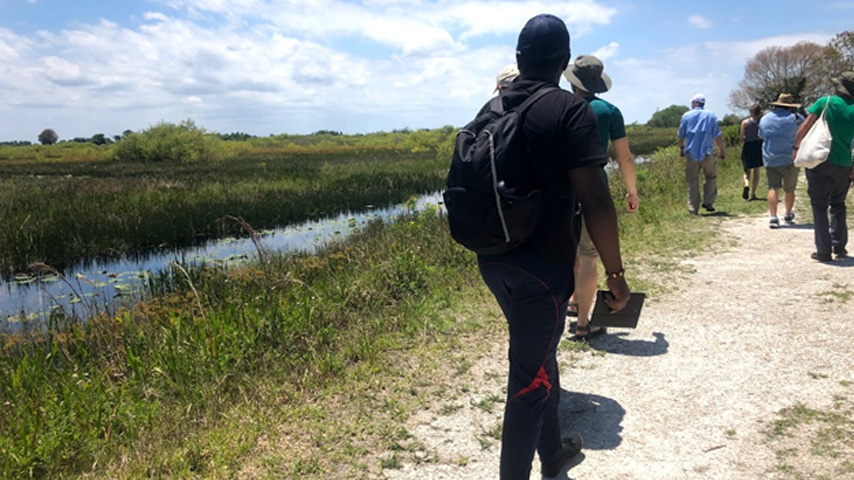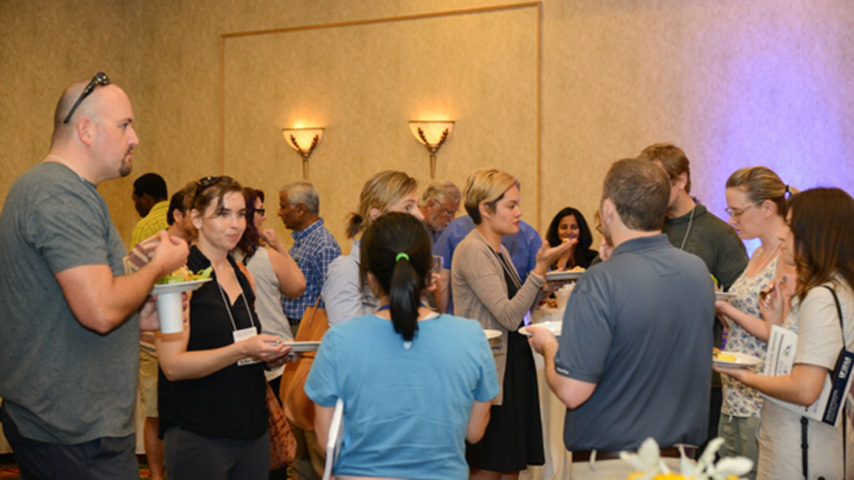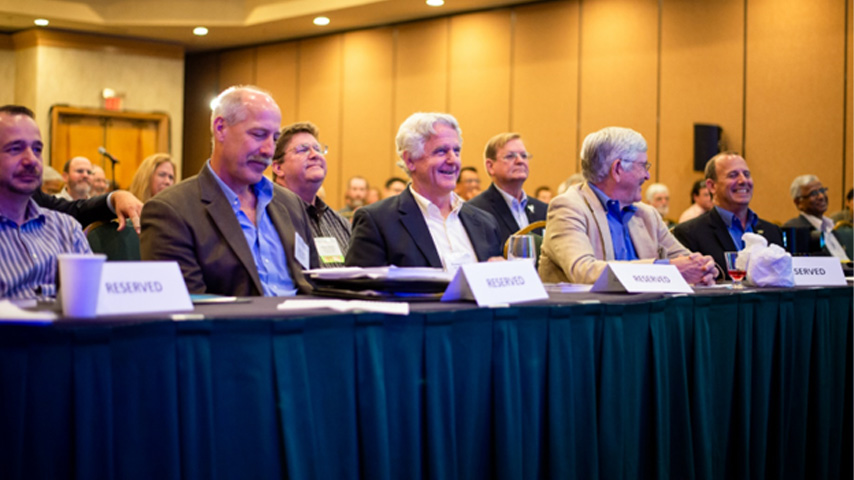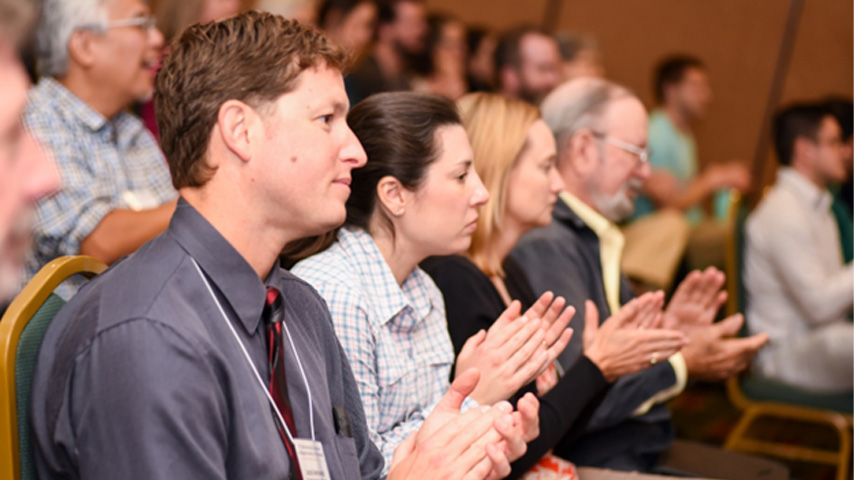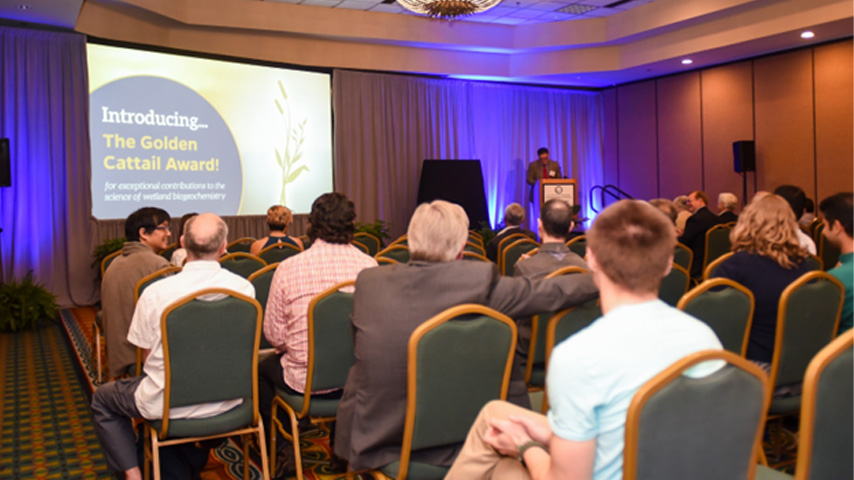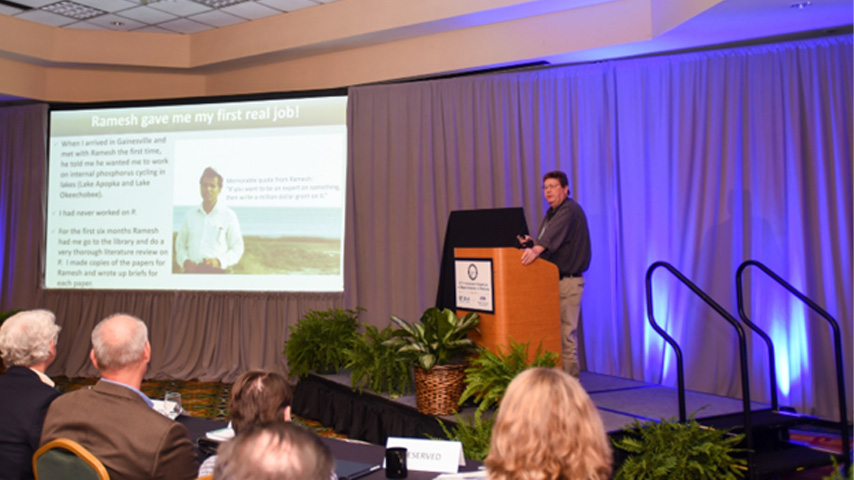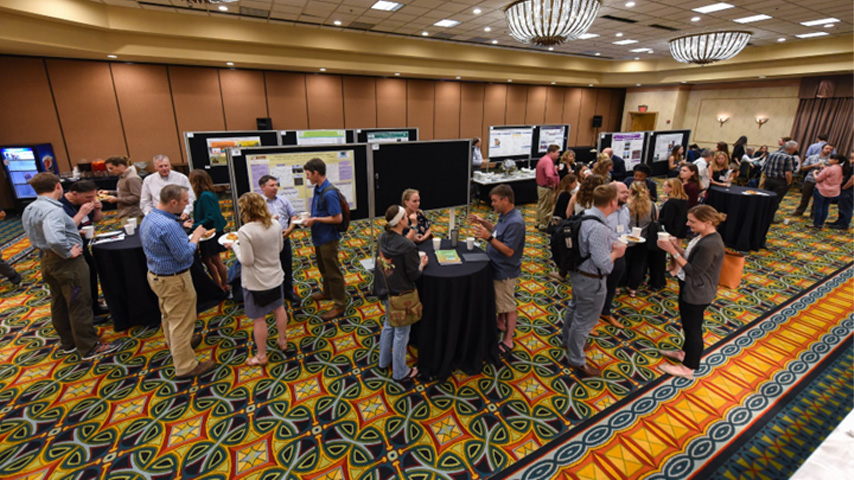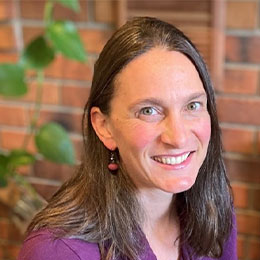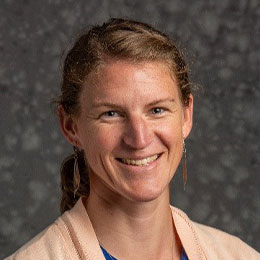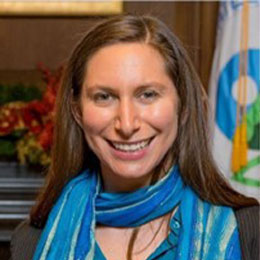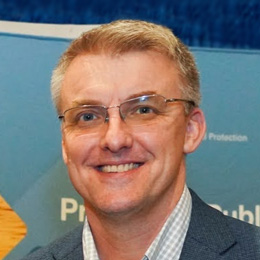| Eloho |
Aghworo |
Louisiana State University |
Does Climate-induced Black Mangrove Replacement of Spartina Change Wetland Soil Carbon Dynamics? |
|
|
|
| Hafez |
Ahmad |
Mississippi State University |
Long-Term Water Quality Trends and Seasonal Drivers in the Western Mississippi Sound: A Remote Sensing and Machine Learning Approach |
|
|
|
| Mysha |
Ahmed |
Louisiana State University |
Evaluating the Impact of Urban and Agricultural Runoff Mitigation Utilizing Waste Valorization for Nutrient Absorption |
|
|
|
| Craig |
Allan |
UNC Charlotte |
Tidal Freshwater Wetland Research on The Santee Experimental Forest – Hydrology and Carbon Dynamics |
|
|
|
| Craig |
Allan |
UNC Charlotte |
The Hydrology and Water Quality Dynamics Associated with an Urban Beaver Pond Complex |
|
|
|
| Wendy |
Ampuero-Reyes |
McGill University |
Stocks and Rates of Organic Carbon Accumulation in Freshwater Impoundments of Eastern Canada |
|
|
|
| Christopher |
Anderson |
Auburn University |
Evaluating Salinity Regimes and Material Exchange Across the Mobile-Tensaw River Delta |
|
|
|
| Marcelo |
Ardon |
North Carolina State University |
Disentangling the Effects of Salinity on Coastal Forest Carbon Balance: From Genes to Landscapes |
|
|
|
| Anna |
Armitage |
Texas A&M University at Galveston |
Belowground Resilience to Freeze Damage in the Texas Gulf Coast Marsh-Mangrove Ecotone |
|
|
|
| Pascal |
Badiou |
Ducks Unlimited Canada |
GHG Emissions from Wetlands in the Canadian Prairies: Impacts of Land-Use Change and Enviromental Drivers |
|
|
|
| Andrew |
Balder |
Auburn University |
Evaluating Woody Plant Species and their Associations with Salinity and Hydrology in the Mobile-Tensaw Delta |
|
|
|
| Sibel |
Bargu |
Louisiana State University |
Examining Hydrological Changes, Nutrient Dynamics, and Cyanobacterial Blooms in Louisiana's Deltaic Estuaries Over a Decade |
|
|
|
| Cadie |
Barnes |
University of Central Florida |
Biogeochemical Impacts of Basalt Fiber Bags on Estuarine Sediment Microbial Activity |
|
|
|
| Jacob |
Berkowitz |
US Army Engineer Research and Development Center |
Practitioner Guidance for Managing Iron Sulfur Compounds During Wetland Restoration |
|
|
|
| Pradipta |
Biswas |
Louisiana State University |
NUMAR 2.0: Advancing Soil Formation Modeling to Embrace Uncertainty in Marsh Environments |
|
|
|
| Josh |
Breithaupt |
Florida State University - Coastal & Marine Lab |
New Ground: Evaluating Factors That Influence Creation of Blue Carbon Soils in Restored and Natural Mangroves in Southwest Florida |
|
|
|
| Sydney |
Bufkin |
ERDC- USACE |
Carbon Sequestration in Wetlands on Military Installations: Assessing Soil Carbon Storage Potential |
|
|
|
| Flavia |
Byekwaso |
University of Natural Resources and Life Sciences |
Tropical Wetlands as Nature-Based Solutions to Remove Pollutants from Stormwater Discharge and Wastewater Effluent in Urban Environments |
|
|
|
| Grace |
Cagle |
University of Wisconsin - Madison |
A Little Goes a Long Way: 1 °C Warming Alters Microbial Metabolic Potential in a Permafrost Peatland |
|
|
|
| Anthony |
Campbell |
NASA/UMBC |
Global Review of Salt Marsh Change and Carbon Emissions |
|
|
|
| Andy |
Canion |
St. Johns River Water Management District |
Biosolids Derived P in the St. Johns River Watershed: Implications for Legacy P Impacts |
|
|
|
| Xingxing |
Cao |
Guizhou University |
Significant Contribution of Wastewater Treatment Plants to Dissolved Carbon Loading in China’s Major River Systems |
|
|
|
| Lisa |
Chambers |
University of Central Florida |
Stability Matters: A New Perspective on Wetland Soil Carbon |
|
|
|
| Lena |
Champlin |
Boston University |
Seasonality and Marsh Zonation Drive Carbon Sequestration Patterns in New England Salt Marshes |
|
|
|
| Samantha |
Chapman |
Villanova University |
Nitrogen Limitation of Mangroves Encroaching into Marshes Depends on Hydrological Positioning |
|
|
|
| Julia |
Charest |
University of Maryland Center for Environmental Science |
The Effect of Prescribed Burning on Nitrification-Coupled Denitrification in a Restored Chesapeake Bay Tidal Marsh |
|
|
|
| Taryn |
Chaya |
University of Florida |
Can Mosquito Impoundments Be Leveraged to Treat Eutrophic Waters? |
|
|
|
| Shu |
Chen |
Shanghai Jiao Tong University |
Uncertainty of Hydrological Processes on Greenhouse Gas Emissions from Urban Rivers |
|
|
|
| Gail |
Chmura |
McGill University |
Assessing the Value of Constructed Wetlands as Nature-Based Climate Solution: Insights from Southern Ontario |
|
|
|
| Rachel |
Collin |
Smithsonian Tropical Research Institute |
A Seasonal Comparison of Decomposition Rates Across 5 Semi-urban Mangrove Sites Spanning a Range of Soil Types and Tidal Regimes |
|
|
|
| Jeffrey |
Cornwell |
University of Maryland Center for Environmental Science |
Pyrite Oxidation and Formation During Dredged Material Wetland Creation Poplar Island, Maryland, USA |
|
|
|
| William |
Crumpton |
Iowa State University |
Nitrous Oxide and Methane Production and Emission in Wetlands Receiving Elevated, Agricultural Nitrate Loads |
|
|
|
| Padmanava |
Dash |
Mississippi State University |
Water Quality Time Series of Mississippi Sound: Insights from Satellite and Unmanned Aerial Systems Imagery and Autonomous Surface Vessel Data |
|
|
|
| Glen |
Delaney |
Earth Economics |
Valuing Forested Wetland Ecosystem Services Belle Pointe Coastal Mitigation Bank |
|
|
|
| Natalia |
Donoso |
Czech University of Life Sciences Prague |
Reactive Materials for Enhanced Removal of Organic Micropollutants in Constructed Wetlands |
|
|
|
| Shawn |
Doyle |
The Water Institute |
Quantifying Spatial and Temporal Uncertainty in Coastal Carbon Dynamics in Louisiana |
|
|
|
| Frank |
Driscoll |
University of Southern Mississippi |
Porewater Salinity Response to Acute and Chronic Climate Disturbances Across Six Basins in Coastal Louisiana |
|
|
|
| Anamika |
Dristi |
Louisiana State University |
A Decade-Long Trend in Dissolved Carbon Dynamics and CO2 Fluxes in the Lower Mississippi River |
|
|
|
| Chelsea |
Duball |
Grand Valley State University |
Documentation of Iron Monosulfide Improves Hydric Soil Identification in the Arid Western U.S. |
|
|
|
| Mikk |
Espenberg |
University of Tartu |
Below- and Aboveground Microbial Carbon and Nitrogen Cycles in Congo Basin Peatland Forests and Grazed Savannas |
|
|
|
| Mikk |
Espenberg |
University of Tartu |
Dynamics of N2O Emissions from Amazonian tropical Peat Forest and Partitioning N-processes Using 15N Isotopes |
|
|
|
| Noah |
Flaherty |
Louisiana State University |
Marsh Salinity and Water Level Dynamics Between the Mississippi River Levee System and Adjacent Coastal Marshes |
|
|
|
| Austin |
Fox |
Florida Tech |
Tracking Diurnal and Episodic Hypoxia and Impacts to Nutrient Cycling in a Shallow, Well-Mixed, Subtropical Estuary |
|
|
|
| Angelina |
Freeman |
Coastal Protection and Restoration Authority |
Coastal Louisiana System-Wide Water Quality Characterization |
|
|
|
| Mohamed S |
Gaballah |
Central Michigan University |
Enhancing the Design of Constructed Wetlands along the Missouri River to Improve Nutrient Removal |
|
|
|
| Kayla |
Garcia |
Marine Biological Laboratory |
Sea Level Rise Alters Salt Marshes’ Carbon Storage Capacity |
|
|
|
| Kevin |
Grace |
DB Environmental |
Dissolved Organic Matter Optical Properties in Treatment Wetlands: Associations with Plants, Soils and Treatment Performance |
|
|
|
| Kara |
Hall |
Mississippi State University |
Assessing Aquatic Macroinvertebrate Communities in Wetland Reserve Easements in the Mississippi Alluvial Valley |
|
|
|
| Songjie |
He |
The University of Southern Mississippi |
Lateral Carbon Flux from a Saltmarsh: Implications for Coastal Acidification and Carbon Budget |
|
|
|
| Alexandra |
Hedgpeth |
UCLA/LLNL |
Surface DOC Fuels Belowground Respiration in a Neotropical Peatland |
|
|
|
| Elizabeth |
Herndon |
Oak Ridge National Laboratory |
Redox Biogeochemistry at High Temporal Resolution in a Freshwater Delta |
|
|
|
| Jing |
Hu |
University of Central Florida |
An Analysis of Long-Term Everglades Stormwater Treatment Areas Performance Using Structural Equation Models |
|
|
|
| Rachael |
Hunter |
Comite Resources, Inc |
Measurement of Greenhouse Gas Flux Across a Hydrologic Gradient in Louisiana Coastal Freshwater Forested Wetlands |
|
|
|
| Jeffrey |
Hutchinson |
University of Texas at San Antonio |
Water Chemistry in Isolated Pools along an Urban Ephemeral Stream in South Central Texas |
|
|
|
| Riley |
Jenkins |
Louisiana State University |
Denitrification and Microbial Processes in Dredge Material Created Wetlands |
|
|
|
| Mike |
Jerauld |
DB Environmental |
Typha Seedling Growth Models Provide Improved Assessment of Treatment Wetland Performance Limitations |
|
|
|
| Scott |
Jones |
University of North Florida |
When and Where can Coastal Wetland Restoration Increase Carbon Sequestration as a Natural Climate Solution? |
|
|
|
| Jonathan |
Judy |
University of Florida |
Soil Amendments to Reduce Phosphorus Leaching from Biosolids-Impacted Soils in the St Johns River Basin |
|
|
|
| Hojeong |
Kang |
Yonsei University |
Are Wetlands a Carbon Sink or Source? – From Microbes to the Globe |
|
|
|
| Shaelynn |
Kaufman |
USACE - Engineer Research & Development Center |
Leveraging Watershed Wetlands to Optimize Phosphorus Management Strategies in Lake Erie Basin |
|
|
|
| Anna |
Knox |
Savannah River National Laboratory |
Removal and Retention of Copper and Zinc in a Constructed Wetland Over 20 Years |
|
|
|
| Lukas |
Lamb-Wotton |
Tulane University |
Mangrove Ecosystem Response to a Historic Snow Event on a Coastal Louisiana Barrier Island |
|
|
|
| Olivia |
Lemieux |
University of Connecticut |
Assessing Salt Marsh Greenhouse Gas Fluxes by Planting Treatment Across Salinity and Elevational Gradients |
|
|
|
| Sophia |
Lingo |
Louisiana State University |
Greenhouse Gas Fluxes in an Active Delta Across a Sediment Organic Matter Gradient |
|
|
|
| Mukseet |
Mahmood |
Louisiana State University |
Impact of Storms on Carbon Cycling in a Rapidly Eroding Estuary in Mississippi Delta Plain |
|
|
|
| Kanchan |
Maiti |
Louisiana State University |
Seasonal Variabilities in Sources and Transport of Dissolved Organic Carbon from a Rapidly Eroding Coastal Estuary in Mississippi River Delta Plain |
|
|
|
| Mason |
Marcantel |
Louisiana State University Agricultural Center |
Developing a Framework for Remote Water Quality Sensing of Nutrients from Urban Wastewater Effluent |
|
|
|
| Walker |
Marechal |
Florida A&M University |
Understanding the Bacterial Community, and their Response to Nutrients in Little Washita River Experimental Watershed Reservoirs, Oklahoma, USA |
|
|
|
| Jason |
Martina |
Texas State University |
Extreme Changes in Water Level and Nutrient Loading Can Shift Freshwater Coastal Wetlands from Nutrient Sinks to Sources |
|
|
|
| Anthony |
Mirabito |
University of Central Florida |
Blue Carbon Stability: Spanning Across Geographical Boundaries |
|
|
|
| Lidia |
Molina Serpas |
University of Alabama |
Nitrogen Mineralization Rates Vary Along a Hydrologic Connectivity Gradient |
|
|
|
| Rica |
Monis |
University of Washington |
Assessing the Seaweed Ulva’s Carbon, Nutrient, and Contaminant Profiles as a Potential Agricultural Soil Amendment |
|
|
|
| Justin |
Murdock |
Tennessee Tech University |
Tradeoffs in Nutrient Retention and Greenhouse Gas Fluxes in Restored Agricultural Wetlands |
|
|
|
| Lucy |
Ngatia |
Florida A&M University |
Post-Hurricane Wood Debris Management Practices: Soil Particle Size Influence Carbon Thermal Stability |
|
|
|
| Genevieve |
Noyce |
Smithsonian Environmental Research Center |
Drivers of Spatial and Temporal Patterns in Methane Emissions from a Brackish Coastal Wetland |
|
|
|
| John Andrew |
Nyman |
Louisiana State University Agricultural Center |
Tropical Storms, Sea-level Rise, and Drawdowns Affect Carbon Accumulation and Elevation Gain in Coastal Marshes |
|
|
|
| Grace |
Orjinwoke |
Florida Agricultural and Mechanical University |
Long Leaf Pine Needle Decomposition: Carbon Composition, Thermal Stability and Nutrient Release Post Hurricane |
|
|
|
| Todd |
Osborne |
University of Florida/IFAS |
Storage and Release of Biosolids P on Poorly Drained Sandy Florida Rangelands Receiving Biosolids Application |
|
|
|
| Michael |
Osland |
U.S. Geological Survey |
Tropicalization of Temperate Wetlands: Projections of Mangrove Range Expansion |
|
|
|
| Emilio |
Payo |
University of Nottingham |
Monitoring Contrasting Belowground and Aboveground Processes as Drivers of Methane Dynamics in Dominant Tropical Peatland Vegetation Communities |
|
|
|
| Mercedes |
Pinzon-Delgado |
University of Central Florida |
Tracing Nitrogen Pathways in Coastal Wetlands: The Role of MAOM in a Changing Landscape |
|
|
|
| Rachel |
Plant |
McGill University |
Ebullitive and Diffusive Greenhouse Gases from Flooded Impoundments of New Brunswick and Nova Scotia (Canada) |
|
|
|
| Christopher |
Potter |
NASA Ames Research Center |
Aerial Image Analysis of Changes in Wetlands between 2019 and 2023 in the Barataria and Breton Sound Basins of Coastal Louisiana |
|
|
|
| Lee |
Potter |
Louisiana State University |
Implications of Phosphorus Loading Pathways on Harmful Algal Blooms in a Coastal Estuary |
|
|
|
| Denise |
Poveda |
Royal Engineering |
Quantification of Belowground Biomass and Sediment Accretion in Mangroves of Different Coastal Environmental Settings of the Costa Rican Pacific Coast |
|
|
|
| Tyler |
Provoncha |
Brevard Zoo |
Utilizing Biogeochemical Approaches to Aid in Pilot-Scale Seagrass Plantings in a Shallow, Well-Mixed Estuary |
|
|
|
| Avalon |
Ramsey |
University of Central Florida |
Factors Influencing Microplastic Abundance in Stormwater Basins |
|
|
|
| Elaine |
Rice |
University of Alabama |
Inundation Regimes Impact on Leaf Litter Decay Rate in Forested, Freshwater Wetlands |
|
|
|
| Curtis |
Richardson |
Duke University |
Pocosins: North America’s Forgotten Peatlands for Climate Mitigation and Sea Level Protection |
|
|
|
| Stephen |
Rigney |
University of Wollongong |
Pre-restoration GHG Dynamics of a Freshwater Coastal Wetland in Southeast Australia |
|
|
|
| Jörg |
Rinklebe |
University of Wuppertal |
Pollution Control in Wetland Soil and Water Around the Globe |
|
|
|
| Victor |
Rivera-Monroy |
Louisiana State University |
Assessing Landscape Cumulative Impacts of Natural and Human Disturbances on Mangrove Carbon Storage in Puerto Rico (Jobos Bay) |
|
|
|
| Mumtahina |
Riza |
University of Central Florida |
How to Increase Mineral-Associated Organic Matter Formation in Organic-Rich Soils |
|
|
|
| Holly |
Roth |
Oak Ridge National Laboratory |
Influence of Redox Processes on Phosphorus Storage, Transformation, and Mobilization |
|
|
|
| Andre |
Rovai |
Smithsonian Environmental Research Center |
Belowground Bio- and Necromass Allocation and Soil Shear Strength across Northern Gulf of Mexico Mangroves |
|
|
|
| Eric |
Roy |
University of Vermont |
Phosphorus Retention in Riparian Wetlands Restored on Formerly Farmed Land: Key Drivers and Lessons for Future Restoration |
|
|
|
| John |
Rybczyk |
Western Washington University |
Carbon Sequestration in the Oldest Tidal Wetlands Resortation Projects Along the West Coast, USA |
|
|
|
| Paula |
Sanchez Garzon |
University of Florida- Gulf Coast Research and Education Center (GCREC) |
Floating Treatment Wetlands with Biochar to Treat Nutrients in a Stormwater Pond |
|
|
|
| Rosanyely |
Santana |
Seminole Tribe of Florida |
Algal Bloom Events and Environmental Drivers in Big Cypress and Brighton Seminole Reservations in Florida |
|
|
|
| Yadav |
Sapkota |
U.S. Army Engineer Research and Development Center |
Formation and Fate of Iron Sulfide Compounds Following Simulated Dredged Sediment Placement in Coastal Wetlands |
|
|
|
| Tracey |
Schafer |
University of Florida- Whitney Laboratory for Marine Biosciences |
Does Benthic Biogeochemistry Drive Algal Blooms in Shallow, Subtropical Florida Lakes? |
|
|
|
| Simone |
Schuster |
Florida State University |
Comparison of Soil Total Nitrogen Stocks and Burial Rates in Natural and Restored Mangrove Forests of Southwest Florida |
|
|
|
| Adam |
Siders |
The University of Alabama |
Assessing the Influence of Breakwaters on Salt Marsh Denitrification Ecosystem Services |
|
|
|
| Lorae |
Simpson |
St. Johns River Water Management District |
Seagrass Sediment Carbon in the Indian River Lagoon, Florida |
|
|
|
| Adam |
Sochacki |
Czech University of Life Sciences Prague |
The Effect Of Manganese Oxides And Ferric Hydroxides On The Treatment Of Greywater In Unsaturated Constructed Wetlands |
|
|
|
| Zoe |
Spielman |
University of Florida |
Linking Phosphorus Storage Mechanisms with Removal Performance in Everglades Stormwater Treatment Wetlands |
|
|
|
| Camille |
Stagg |
U.S. Geological Survey |
Modeling Climate and Land Use Change Impacts on Net Ecosystem Carbon Balance in Coastal Wetlands |
|
|
|
| Alan |
Steinman |
Grand Valley State University |
Understanding the Great Lakes: It Is More Than Just Phosphorus |
|
|
|
| Havalend |
Steinmuller |
Louisiana Universities Marine Consortium |
“Going Local”: Addressing Heterogeneity in Biogeochemical Cycling in Mangrove Systems through Sedimentary Setting and Geomorphology |
|
|
|
| Benjamin |
Sulman |
Oak Ridge National Laboratory |
Modeling Wetland Redox Biogeochemistry and Vegetation Function at Site to Continental Scales |
|
|
|
| Corianne |
Tatariw |
Rowan University |
Does Mangrove Encroachment Enhance Biogeochemical Resilience to Sea Level Rise? |
|
|
|
| Jose |
Tercero |
Louisiana State University |
Assessment of Soil Greenhouse Gas Fluxes Along a Salinity Gradient in Coastal Deltaic Floodplain of Louisiana |
|
|
|
| Nikolaos |
Toumasis |
Cranfield University |
Using Long-Term Monitoring Datasets to Demine Wetland Resilience |
|
|
|
| John |
Tracy |
Louisiana State University |
Soil and Groundwater Dynamics Within Varying Land Classes of a Proposed Forested Wetland Mitigation Bank |
|
|
|
| S.M. Mahatab |
Uddin |
DOCS-LSU |
Mangrove Wetlands Leaf Productivity and Expansion are Controlled by Air Temperature, Phosphorus Availability, and Salinity in Port Fourchon, Louisiana, USA |
|
|
|
| Shristi |
Upadhyaya |
Louisiana State University Agricultural Center |
Investigating the Cycling of Nutrients from Seafood Processors' Waste in Organic Fertilizer |
|
|
|
| George |
Vetushko |
University of California, Los Angeles |
Does Agricultural Runoff Influence Anaerobic Methanotrophy in a Southern Californian Wetland? |
|
|
|
| Jan |
Vymazal |
Czech University of Life Sciences Prague |
Distribution of Heavy Metals in Plants Growing in Constructed Treatment Wetlands |
|
|
|
| Nicholas |
Wagner |
Louisiana State University Agricultural Center |
Spatial Evaluation of Water Quality Parameters to Optimize Nutrients and Dissolved Oxygen for Crawfish Ponds |
|
|
|
| Dongqi |
Wang |
East China Normal University |
Unraveling the Drivers of Bubble Methane Emissions in Urban Rivers: The Roles of Organic CarbonTemperature, and Water Depth |
|
|
|
| Hongqing |
Wang |
U.S. Geological Survey |
Modeling Carbon Fluxes in Forested Wetlands in the Mississippi River Deltaic Plain Under Various Hydrologic Conditions |
|
|
|
| Jiaze |
Wang |
University of Maine |
Methane Escape from the Deteriorating Mississippi River Delta |
|
|
|
| Shengsen |
Wang |
Yangzhou University |
Biochar Mitigated Zerovalent Iron-Induced Methane Emissions in an Arsenic-Contaminated Paddy Soil: the Mechanism |
|
|
|
| Yang |
Wang |
Wuhan Institute of Technology |
Diel Fluctuation of Carbon Dioxide Emission Affected by Eutrophication and Dissolved Organic Matter in China’s Largest Urban Lake |
|
|
|
| Yongjie |
Wang |
East China Normal University |
Mercury Properties and Transformations in Wetland Sediments of the Changjiang Estuary |
|
|
|
| Elizabeth |
Watson |
Stony Brook University |
Investigation of Salt Marsh Platform Vegetation Stress Indicators to Reveal Potential Marsh Loss Mechanisms |
|
|
|
| Rachel |
Weisend |
Texas A&M University - Corpus Christi |
Microbe Mischief: How Microbes Drive Cryptic Cycling In Mangrove Wetlands |
|
|
|
| John |
White |
Louisiana State University |
Consequences of River Reconnection on Water Quality in Barataria Bay |
|
|
|
| Emily |
Wilson |
Boston University |
Meta-analysis Describing How Plant Species Composition Drives Salt Marsh Greenhouse Gas Fluxes |
|
|
|
| Avery |
Wissmueller |
Mississippi State University |
Assessing Water Quality of Wetland Reserve Easements in the Mississippi Alluvial Valley |
|
|
|
| Fanyan |
Yang |
East China Normal University |
Effects of Chlorinated Disinfectants on Greenhouse Gases Emissions from Urban Inland Waters |
|
|
|
